By Health Editor
Within the circle of religious architecture, however, its fame probably surpasses that of any other temple in China, because it is a royal temple built during the Liao Dynasty and the only Liao temple remaining in China.
Fengguo Temple is more than a temple. It embodies many accomplishments in architecture, sculpture, painting, and archaeology. Liang Sicheng, the most authoritative architectural historian of China, called it a national treasure and a treasure among treasures.
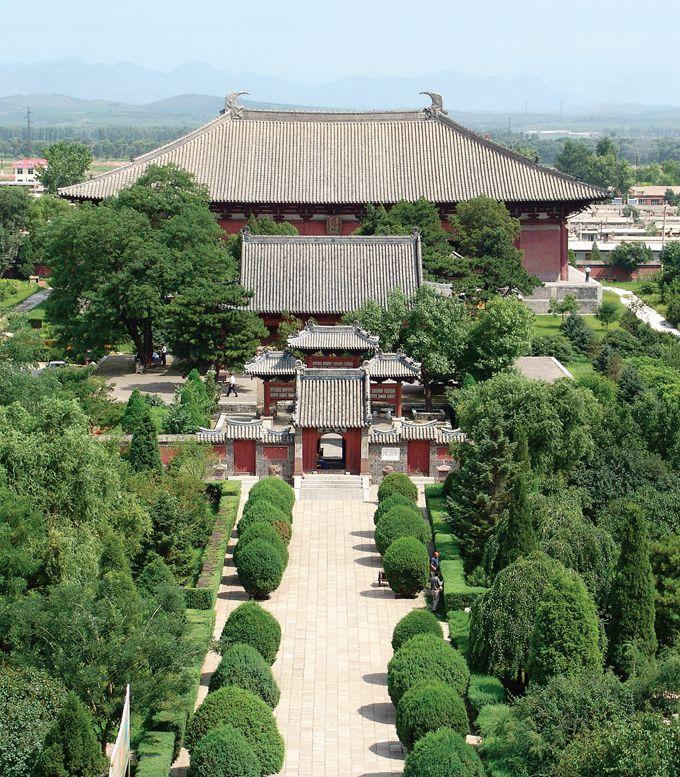
Empress Dowager’s Legend
In the period of the Song Dynasty(960-1279), Buddhism was in relative decay in China’s Central Plain, while in the Northern kingdom of Liao, it became its national religion. This had much to do with its Empress Dowager, Xiao, who was a devout Buddhist and was also believed to be the reincarnated Heavenly Queen Mother.
Her son, Emperor Shengzong (Yelü Longxu), claimed himself to be the reincarnated Sakyamuni. After Empress Dowager Xiao passed away, Emperor Shengzong built the temple in the 9th year of his reign (1020), in Yi County, the hometown of the Empress Dowager. He wanted to commemorate his mother and also to promote Buddhism. Today, the temple is claimed to be the bodhimandala (or dojo) of Sakyamuni.
Fengguo Temple was named Xianxi Temple, or the “Temple of Enlightenment for All,” in the Liao Dynasty, and later became Fengguo Temple during the Jin Dynasty (1115-1234). The temple also gained its folk names the “Temple of Grand Buddha” and later the “Temple of Seven Buddhas” for its seven grand Buddha statues in the temple’s Mahavira Hall. After generations of rebuilding and renovating, the present-day Fengguo Temple has been restored to the glory and the completeness of when it was first built.
According to historical records, the heyday of the temple was from the Liao and Jin to the beginning of the Yuan Dynasty (1279-1368). The architecture at the time was magnificent . The temple’s decay began from the end of the Yuan Dynasty due to constant warfare.
By the Qing Dynasty (1644–1911), only Mahavira Hall remained standing. The six-cornered Bell Pavilion, the four-cornered Stele Pavilion, the Amitabha Hall, the Memorial Arch, the Small Hill Gate, and the West Court Auspice Hall were all constructed in the Qing Dynasty.
Wooden Structure
Located precisely north of the north-south axis of the temple, Mahavira Hall, being the temple’s only building surviving from the Liao Dynasty, towers aloft on an open platform. The hall bears the structure of five ridges, a single eave, and a hipped roof. It measures more than 1800 square meters and it is China’s largest wooden-structured building dating back to the Liao Dynasty.
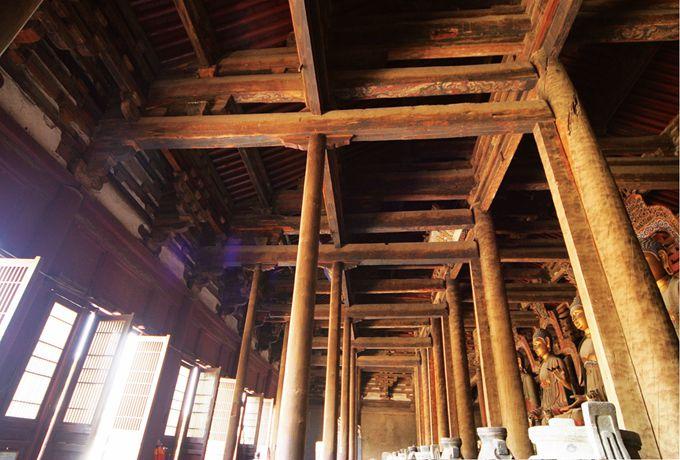
The entire hall was sustained by wooden structures of beams, pillars, girders, and bucket arches without the use of a single metal nail. The method of “pillarless inner space” was employed to the interior and exterior elements of the temple’s seven central compartments. The corner posts lean inwards to strengthen the pillars’ tensile strength. The bracket arches underneath the eave were made of thick and bulky materials, taking on a rough and concise appearance as well as one of grandeur.
By following the principles of mechanics, the supporting beams have remained straight, without any warping, for over a thousand years. Fengguo Temple is a splendid example of traditional Chinese wooden architecture at its finest.
Seven Buddhas
Most Buddhist temples contain one, three, or five Buddha statues in their main halls. The Mahavira Hall in Fengguo Temple uniquely displays seven “Past Buddhas” for offering and worship.

On the high altar, seven Buddha statues were arranged from east to west: Kassapo, Kakusandho, Sikhin, Vipassi, Vessabhū, Konāgamano, and Sakyamuni. The statue of Vipassi in the middle is the tallest, measuring 8.6 meters in height including it’s pedestal.
Other statues on both sides are of gradually decreasing heights. The statue of Sakyamuni faces slightly west, as if facing his hometown. Each Buddha statue is dignified and solemn, tall and kind, lofty and auspicious, and awe-inspiring.
Each Buddha statue is flanked by two bodhisattvas (more than 2.5 meters in height), sculptured vividly and beautifully. There are 14 of them in total. At the east and west ends of the altar, stand two statues of mighty and brave guardian kings. Behind the statue of Vipassi, sits a male statue of Bodhisattva Skanda, facing away. It is an eye-catching wooden statue re-sculptured in the Ming Dynasty (1368-1644).
Heavenly Beauties
On the beams and arches are paintings from the Liao Dynasty, rarely seen in China. These paintings include subjects such as Feitian figures, lotus flowers, sea pomegranate and phoenixes, displayed in vivid colors and animated forms.
In Buddhism, Feitian figures are flying heavenly beauties. The Feitian figures in Fengguo Temple were painted in great detail and depth with rich colors. Each Feitian has a mellow and joyful face, wears colorful clothing, and is showing beautiful gestures.
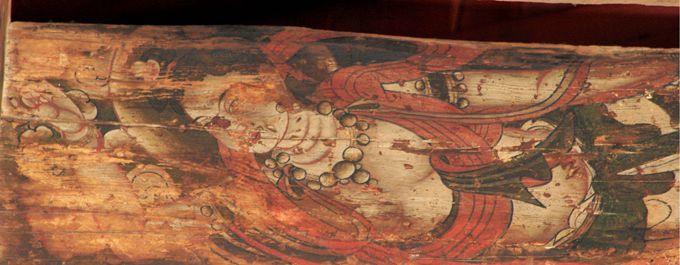
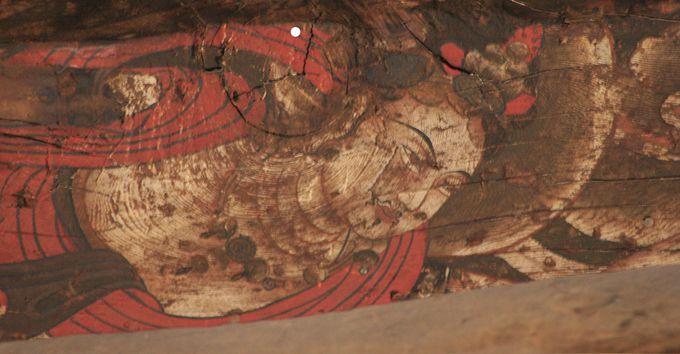
The Feitian figures in Fengguo Temple all have halos around their heads, wearing crowns or double hair buns. Their faces are full and kind, their eyebrows curved and their lips red. They wear ribbon-like keyuras, bracelets, and heavenly dress. Their faces are mostly those of a male or a boy. The male faces have tadpole-like beards, and the boy faces have double hair buns. Their bodies are in-between that of a male and a female, which is classic representation in traditional Buddhism.
Amongst all the remaining Feitian figures, only the 30th is a female. They have much of the Tang Dynasty’s style. They fly and dance right above the seven Buddhas, some hold bouquets, some hold fruit plates, and some cast flowers over the clouds for offering, echoing with the seven Buddhas directly beneath. Their animation is in contrast to the Buddhas’ serenity, which makes a solemn picture of worship.
All three sidewalls in the hall display murals. Five Buddhas are painted on the eastern and western walls and eight Bodhisattvas on the northern wall, all works of the Yuan Dynasty.
The main wall used to have a painting of eighteen Arhats, but this was taken down during repairs in 1984 and is now preserved in the back of the hall. The painting dates back to the Ming Dynasty.
Miraculous Survival
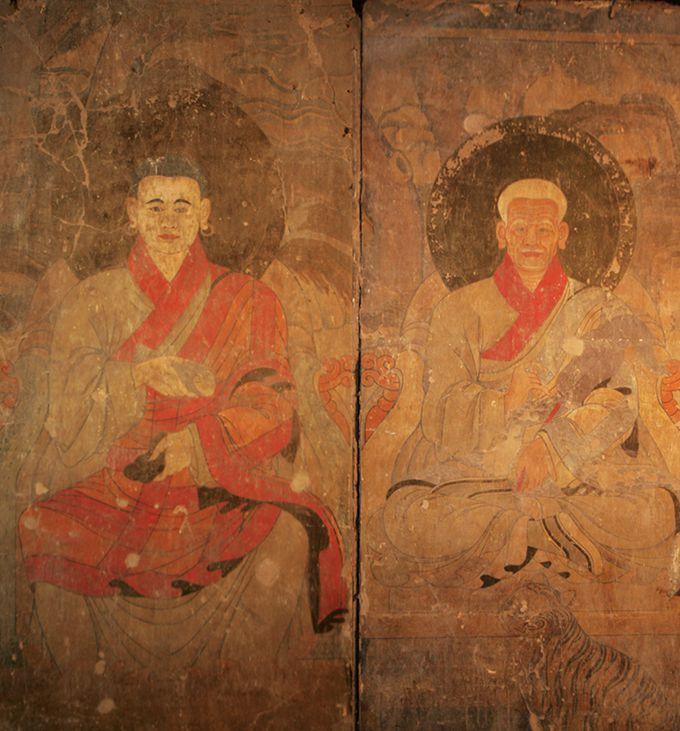
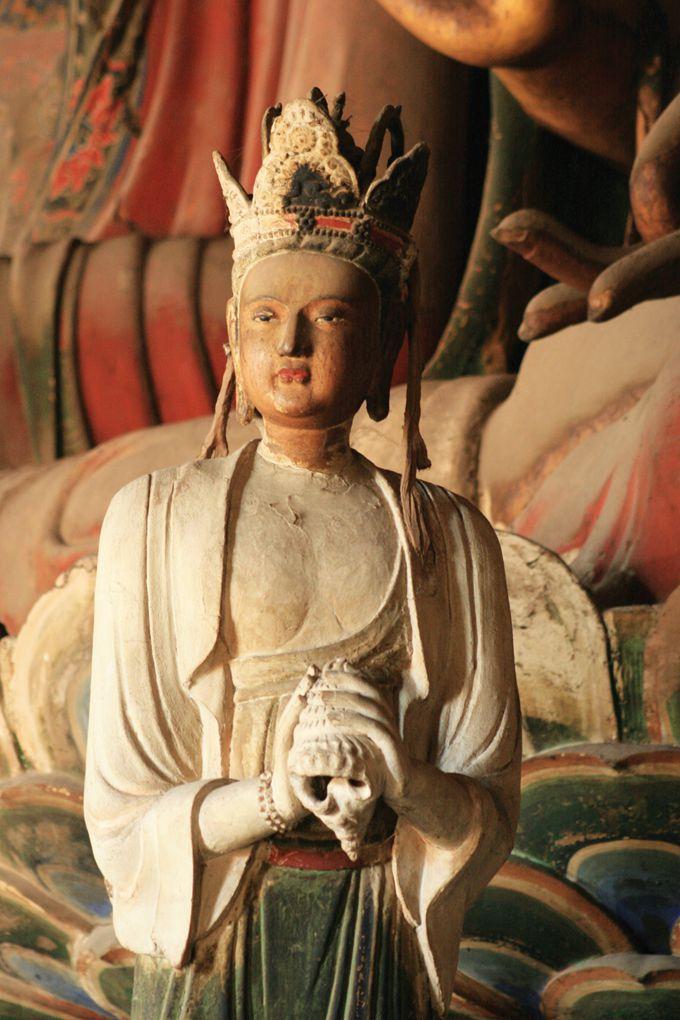
In the past thousands of years, all the well-known ancient temples in China have been devastated by the destruction of their original buildings—except for Fengguo Temple, which worships the seven original Buddhas. It miraculously repelled five disastrous events in history: the war of Jin conquering Liao, the war of Yuan conquering Jin, the big earthquake during the Yuan Dynasty, but the fourth and the fifth were the most traumatic.
The fourth disaster was the battle in the Yi County that was part of the Liao-Shen military campaign of the Chinese Civil War. On Oct. 1, 1948, a bomb shell penetrated the roof of Mahavira Hall and landed exactly into the conjoined hands of Sakyamuni’s statue. The bomb did not explode. It only slightly damaged the right hand of the statue (which has since been repaired). Furthermore, two bombs landed in the temple and did not explode, either.
The fifth disaster was the Cultural Revolution. In 1966, the Red Guards set about destroying temples and Buddha statues all around the country, as part of the “Destroying the Four Olds” movement. There were more than ten visits to Fengguo Temple by Red Guards from all over the nation, who claimed that they would destroy this “old world” including the Buddha statues.
Mr. Liu Qian, a historical relic expert of Fengguo temple, showed the Red Guards a sign issued by the State Council in 1961, which marked the temple a protected key cultural relic, and he explained to them the temple’s significance as a national treasure. As a result, not only did no other Red Guards touch the temple, but the Red Guards from the Qinghua University went so far as to write a banner saying “Revolutionary rebels should protect cultural relics” at Fengguo Temple.
The rebel groups coming to the temple later, all left upon seeing the banner. The buildings and Buddha statues were preserved as a result. This was truly a miracle for the time of the Cultural Revolution. Perhaps it was the beauty of the sacred Buddhist temple itself that made the deranged minds of the Red Guards come to their senses.
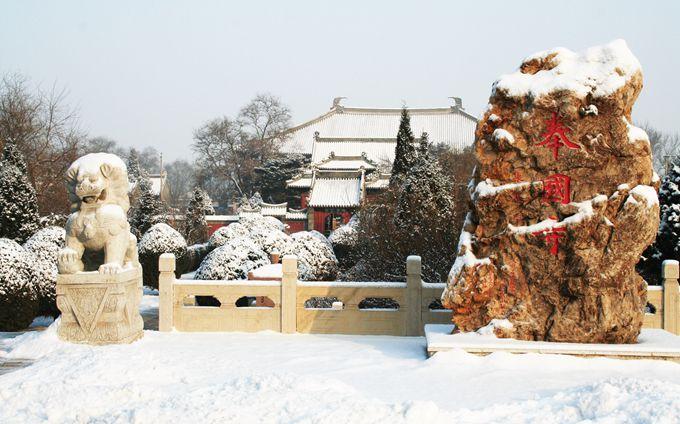
Over the past thousand years, there have been many stories about the magical, divine power of the seven Buddhas of the Past in the Fengguo Temple. Enduring destruction from heaven and men for the past one thousand years, the seven Buddhas remain to this day along with the Mahavira Hall, retaining their wisdom of uniting heaven with mankind.
The two tablets on both sides of the gate to the hall proclaim, “What illuminates Heaven and Earth is the Wheel of the Law; and what nurtures the mountains and the rivers is the compassion of the Buddhas.” This place is undoubtedly worth a trip, even more so if one can truly enlighten to the deeper meaning.
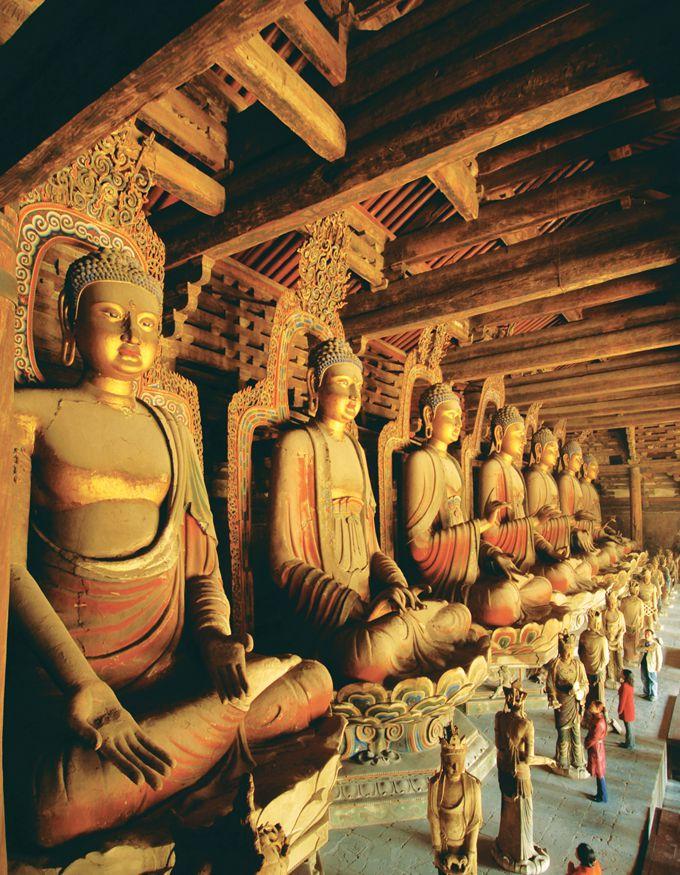
Article : Qin Xin
Translation : David Li
Photo : Fenggou Temple

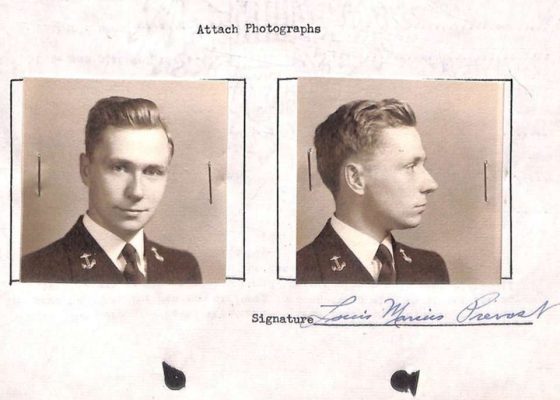
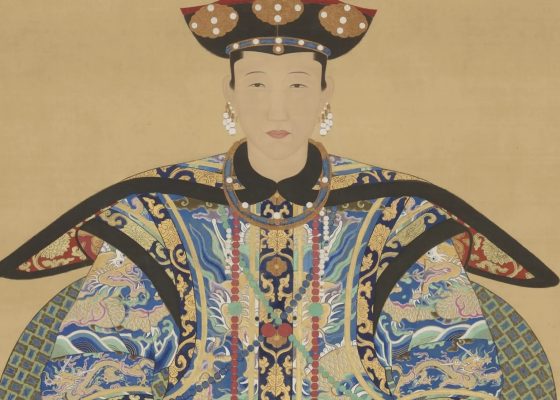



Cancel anytime


Using our website
You may use the The Middle Land website subject to the Terms and Conditions set out on this page. Visit this page regularly to check the latest Terms and Conditions. Access and use of this site constitutes your acceptance of the Terms and Conditions in-force at the time of use.
Intellectual property
Names, images and logos displayed on this site that identify The Middle Land are the intellectual property of New San Cai Inc. Copying any of this material is not permitted without prior written approval from the owner of the relevant intellectual property rights.
Requests for such approval should be directed to the competition committee.
Please provide details of your intended use of the relevant material and include your contact details including name, address, telephone number, fax number and email.
Linking policy
You do not have to ask permission to link directly to pages hosted on this website. However, we do not permit our pages to be loaded directly into frames on your website. Our pages must load into the user’s entire window.
The Middle Land is not responsible for the contents or reliability of any site to which it is hyperlinked and does not necessarily endorse the views expressed within them. Linking to or from this site should not be taken as endorsement of any kind. We cannot guarantee that these links will work all the time and have no control over the availability of the linked pages.
Submissions
All information, data, text, graphics or any other materials whatsoever uploaded or transmitted by you is your sole responsibility. This means that you are entirely responsible for all content you upload, post, email or otherwise transmit to the The Middle Land website.
Virus protection
We make every effort to check and test material at all stages of production. It is always recommended to run an anti-virus program on all material downloaded from the Internet. We cannot accept any responsibility for any loss, disruption or damage to your data or computer system, which may occur while using material derived from this website.
Disclaimer
The website is provided ‘as is’, without any representation or endorsement made, and without warranty of any kind whether express or implied.
Your use of any information or materials on this website is entirely at your own risk, for which we shall not be liable. It is your responsibility to ensure any products, services or information available through this website meet your specific requirements.
We do not warrant the operation of this site will be uninterrupted or error free, that defects will be corrected, or that this site or the server that makes it available are free of viruses or represent the full functionality, accuracy and reliability of the materials. In no event will we be liable for any loss or damage including, without limitation, loss of profits, indirect or consequential loss or damage, or any loss or damages whatsoever arising from the use, or loss of data, arising out of – or in connection with – the use of this website.
Last Updated: September 11, 2024
New San Cai Inc. (hereinafter “The Middle Land,” “we,” “us,” or “our”) owns and operates www.themiddleland.com, its affiliated websites and applications (our “Sites”), and provides related products, services, newsletters, and other offerings (together with the Sites, our “Services”) to art lovers and visitors around the world.
This Privacy Policy (the “Policy”) is intended to provide you with information on how we collect, use, and share your personal data. We process personal data from visitors of our Sites, users of our Services, readers or bloggers (collectively, “you” or “your”). Personal data is any information about you. This Policy also describes your choices regarding use, access, and correction of your personal information.
If after reading this Policy you have additional questions or would like further information, please email at middleland@protonmail.com.
PERSONAL DATA WE COLLECT AND HOW WE USE IT
We collect and process personal data only for lawful reasons, such as our legitimate business interests, your consent, or to fulfill our legal or contractual obligations.
Information You Provide to Us
Most of the information Join Talents collects is provided by you voluntarily while using our Services. We do not request highly sensitive data, such as health or medical information, racial or ethnic origin, political opinions, religious or philosophical beliefs, trade union membership, etc. and we ask that you refrain from sending us any such information.
Here are the types of personal data that you voluntarily provide to us:
As a registered users or customers, you may ask us to review or retrieve emails sent to your business. We will access these emails to provide these services for you.
We use the personal data you provide to us for the following business purposes:
Information Obtained from Third-Party Sources
We collect and publish biographical and other information about users, which we use to promote the articles and our bloggers who use our sites. If you provide personal information about others, or if others give us your information, we will only use that information for the specific reason for which it was provided.
Information We Collect by Automated Means
Log Files
The site uses your IP address to help diagnose server problems, and to administer our website. We use your IP addresses to analyze trends and gather broad demographic information for aggregate use.
Every time you access our Site, some data is temporarily stored and processed in a log file, such as your IP addresses, the browser types, the operating systems, the recalled page, or the date and time of the recall. This data is only evaluated for statistical purposes, such as to help us diagnose problems with our servers, to administer our sites, or to improve our Services.
Do Not Track
Your browser or device may include “Do Not Track” functionality. Our information collection and disclosure practices, and the choices that we provide to customers, will continue to operate as described in this Privacy Policy, whether or not a “Do Not Track” signal is received.
HOW WE SHARE YOUR INFORMATION
We may share your personal data with third parties only in the ways that are described in this Privacy Policy. We do not sell, rent, or lease your personal data to third parties, and We does not transfer your personal data to third parties for their direct marketing purposes.
We may share your personal data with third parties as follows:
There may be other instances where we share your personal data with third parties based on your consent.
HOW WE STORE AND SECURE YOUR INFORMATION
We retain your information for as long as your account is active or as needed to provide you Services. If you wish to cancel your account, please contact us middleland@protonmail.com. We will retain and use your personal data as necessary to comply with legal obligations, resolve disputes, and enforce our agreements.
All you and our data are stored in the server in the United States, we do not sales or transfer your personal data to the third party. All information you provide is stored on a secure server, and we generally accepted industry standards to protect the personal data we process both during transmission and once received.
YOUR RIGHTS/OPT OUT
You may correct, update, amend, delete/remove, or deactivate your account and personal data by making the change on your Blog on www.themiddleland.com or by emailing middleland@protonmail.com. We will respond to your request within a reasonable timeframe.
You may choose to stop receiving Join Talents newsletters or marketing emails at any time by following the unsubscribe instructions included in those communications, or you can email us at middleland@protonmail.com
LINKS TO OTHER WEBSITES
The Middle Land include links to other websites whose privacy practices may differ from that of ours. If you submit personal data to any of those sites, your information is governed by their privacy statements. We encourage you to carefully read the Privacy Policy of any website you visit.
NOTE TO PARENTS OR GUARDIANS
Our Services are not intended for use by children, and we do not knowingly or intentionally solicit data from or market to children under the age of 18. We reserve the right to delete the child’s information and the child’s registration on the Sites.
PRIVACY POLICY CHANGES
We may update this Privacy Policy to reflect changes to our personal data processing practices. If any material changes are made, we will notify you on the Sites prior to the change becoming effective. You are encouraged to periodically review this Policy.
HOW TO CONTACT US
If you have any questions about our Privacy Policy, please email middleland@protonmail.com
The Michelin brothers created the guide, which included information like maps, car mechanics listings, hotels and petrol stations across France to spur demand.
The guide began to award stars to fine dining restaurants in 1926.
At first, they offered just one star, the concept was expanded in 1931 to include one, two and three stars. One star establishments represent a “very good restaurant in its category”. Two honour “excellent cooking, worth a detour” and three reward “exceptional cuisine, worth a
Thank you for your participation,
please Log in or Sign up to Vote

123Sign in to your account